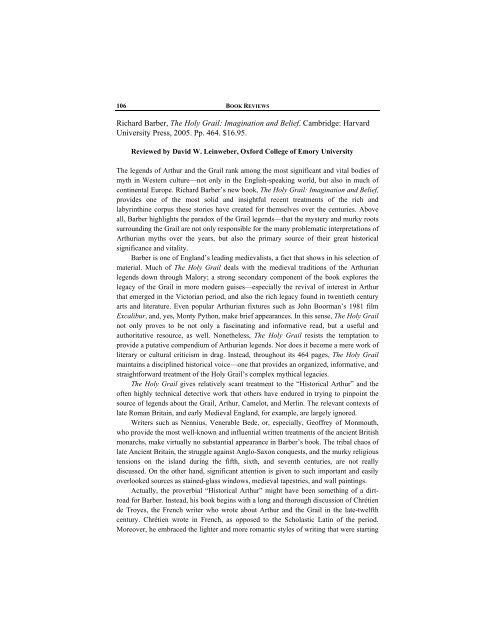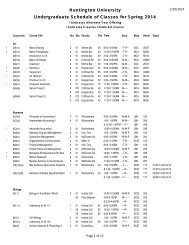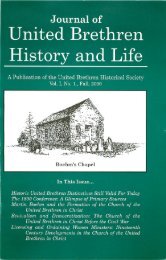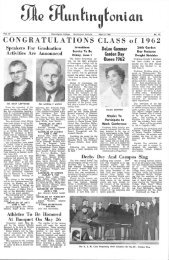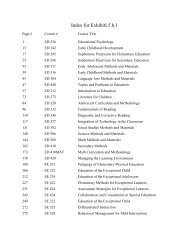Gillian Clark, Christianity and Roman Society - Huntington University
Gillian Clark, Christianity and Roman Society - Huntington University
Gillian Clark, Christianity and Roman Society - Huntington University
You also want an ePaper? Increase the reach of your titles
YUMPU automatically turns print PDFs into web optimized ePapers that Google loves.
106 BOOK REVIEWS<br />
Richard Barber, The Holy Grail: Imagination <strong>and</strong> Belief. Cambridge: Harvard<br />
<strong>University</strong> Press, 2005. Pp. 464. $16.95.<br />
Reviewed by David W. Leinweber, Oxford College of Emory <strong>University</strong><br />
The legends of Arthur <strong>and</strong> the Grail rank among the most significant <strong>and</strong> vital bodies of<br />
myth in Western culture—not only in the English-speaking world, but also in much of<br />
continental Europe. Richard Barber’s new book, The Holy Grail: Imagination <strong>and</strong> Belief,<br />
provides one of the most solid <strong>and</strong> insightful recent treatments of the rich <strong>and</strong><br />
labyrinthine corpus these stories have created for themselves over the centuries. Above<br />
all, Barber highlights the paradox of the Grail legends—that the mystery <strong>and</strong> murky roots<br />
surrounding the Grail are not only responsible for the many problematic interpretations of<br />
Arthurian myths over the years, but also the primary source of their great historical<br />
significance <strong>and</strong> vitality.<br />
Barber is one of Engl<strong>and</strong>’s leading medievalists, a fact that shows in his selection of<br />
material. Much of The Holy Grail deals with the medieval traditions of the Arthurian<br />
legends down through Malory; a strong secondary component of the book explores the<br />
legacy of the Grail in more modern guises—especially the revival of interest in Arthur<br />
that emerged in the Victorian period, <strong>and</strong> also the rich legacy found in twentieth century<br />
arts <strong>and</strong> literature. Even popular Arthurian fixtures such as John Boorman’s 1981 film<br />
Excalibur, <strong>and</strong>, yes, Monty Python, make brief appearances. In this sense, The Holy Grail<br />
not only proves to be not only a fascinating <strong>and</strong> informative read, but a useful <strong>and</strong><br />
authoritative resource, as well. Nonetheless, The Holy Grail resists the temptation to<br />
provide a putative compendium of Arthurian legends. Nor does it become a mere work of<br />
literary or cultural criticism in drag. Instead, throughout its 464 pages, The Holy Grail<br />
maintains a disciplined historical voice—one that provides an organized, informative, <strong>and</strong><br />
straightforward treatment of the Holy Grail’s complex mythical legacies.<br />
The Holy Grail gives relatively scant treatment to the “Historical Arthur” <strong>and</strong> the<br />
often highly technical detective work that others have endured in trying to pinpoint the<br />
source of legends about the Grail, Arthur, Camelot, <strong>and</strong> Merlin. The relevant contexts of<br />
late <strong>Roman</strong> Britain, <strong>and</strong> early Medieval Engl<strong>and</strong>, for example, are largely ignored.<br />
Writers such as Nennius, Venerable Bede, or, especially, Geoffrey of Monmouth,<br />
who provide the most well-known <strong>and</strong> influential written treatments of the ancient British<br />
monarchs, make virtually no substantial appearance in Barber’s book. The tribal chaos of<br />
late Ancient Britain, the struggle against Anglo-Saxon conquests, <strong>and</strong> the murky religious<br />
tensions on the isl<strong>and</strong> during the fifth, sixth, <strong>and</strong> seventh centuries, are not really<br />
discussed. On the other h<strong>and</strong>, significant attention is given to such important <strong>and</strong> easily<br />
overlooked sources as stained-glass windows, medieval tapestries, <strong>and</strong> wall paintings.<br />
Actually, the proverbial “Historical Arthur” might have been something of a dirtroad<br />
for Barber. Instead, his book begins with a long <strong>and</strong> thorough discussion of Chrétien<br />
de Troyes, the French writer who wrote about Arthur <strong>and</strong> the Grail in the late-twelfth<br />
century. Chrétien wrote in French, as opposed to the Scholastic Latin of the period.<br />
Moreover, he embraced the lighter <strong>and</strong> more romantic styles of writing that were starting


